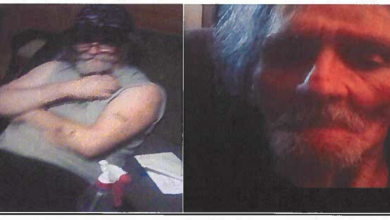Last letters of mountaineering pioneer who died on Everest reveal the dark side of mountaineering
Sign up for CNN’s Wonder Theory science newsletter. Explore the universe with information on fascinating discoveries, scientific advances and much more..
George Mallory is renowned for being one of the first British mountaineers to attempt to scale the dizzying heights of Mount Everest in the 1920s – until the mountain claimed his life.
Nearly a century later, newly digitized letters have shed light on Mallory’s hopes and fears about climbing Everest, right up to the final days before he vanished on his way to its summit.
On June 8, 1924, Mallory and another climber Andrew Irvine left their expedition team to head to the summit; they were never seen alive again.
Mallory’s lyrics, however, are now available online for the first time in their entirety. Magdalene College, Cambridge, where Mallory studied from 1905 to 1908, recently digitized hundreds of pages of correspondence and other documents he wrote and received.
Over the past 18 months, archivists have been digitizing records in preparation for the centenary of Mallory’s disappearance. The college will display a selection of Mallory’s letters and possessions in the exhibition “George Mallory: Magdalene to the Mountain,” which opens June 20.
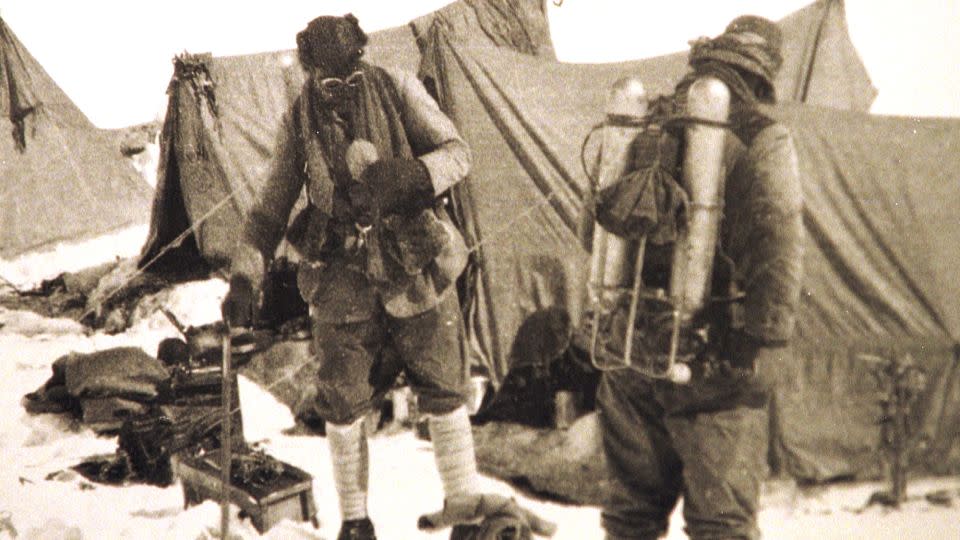

The Everest Letters describe Mallory’s meticulous preparations and equipment testing, as well as her optimism about their prospects. But the letters also show the darker side of mountaineering: bad weather, health problems, setbacks and doubts.
Days before his disappearance, Mallory wrote that the odds were “50 to 1 against us” in the last letter to his wife, Ruth, dated May 27, 1924.
“It’s been a bad time,” Mallory wrote. “I think back to enormous effort, exhaustion and the dismal view through a tent door and onto a world of snow and vanishing hopes.”
He later described coming close to death on a recent climb, when the ground beneath his feet collapsed, leaving him hanging “half blind and out of breath”, his weight supported only by his ice ax stuck in a crevasse as he ‘he was swinging above. “a very unpleasant black hole.”
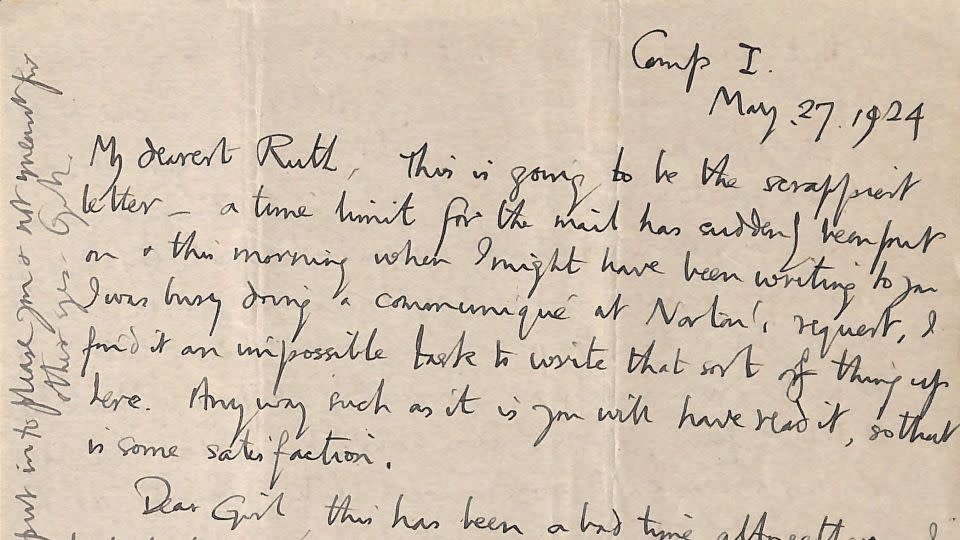

Other letters Mallory exchanged with Ruth were written during their courtship, while he was serving in the British artillery regiment during the First World War. Throughout her travels, Ruth’s correspondence provided much-needed stability during the most difficult times, the project said. » directs Katy Green, university archivist at Magdalene College.
“She was the ‘rock’ of the house, he himself said in his letters,” Green said. The archivist recounted a note in which Mallory told Ruth, “I’m so glad you never wavered, because I would waver without you.” »
Yet even though Mallory was clearly devoted to his wife, he nevertheless returned repeatedly to the Himalayas despite his growing fears for her safety.
“There was something about him that motivated him,” Green said. “It could be due to his war experience, or just the kind of person he was.”
“Documents about his character”
In total, the collection includes approximately 840 letters ranging from 1914 to 1924; Ruth wrote about 440 to Mallory, providing an unprecedented and highly detailed view of the daily lives of women in the early 20th century, Green told CNN.
Together, the letters offer readers a rare glimpse into the man behind the legend, said Jochen Hemmleb, an author and climber who was part of the Everest expedition that found Mallory’s body in 1999.
“They’re really personal. These are documents of his character. They provide a unique insight into his life, and in particular the 1924 expedition: his state of mind, his precise planning, his ambitions,” said Hemmleb, who was not involved in the digitization project. “C “It’s such a treasure that they are now digitized and accessible to everyone.”
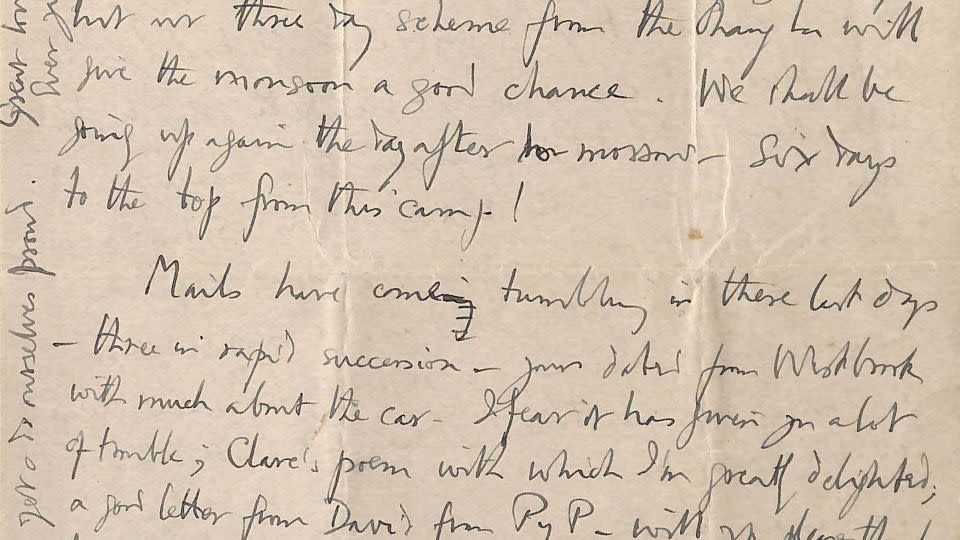

Frozen in place
Three of the digitized letters – written to Mallory by her brother, sister and a family friend – were recovered from Mallory’s body by Mallory and Irvine’s search expedition, which climbed Everest in search of the remains of Mallory and Irvine.
On May 1, 1999, expedition member and mountaineer Conrad Anker found a frozen corpse at an altitude of approximately 26,700 feet (8,138 meters) and identified it as Mallory’s by a name tag. sewn on his clothes.
Mallory’s body was buried where he lay at the family’s request, said Anker, who was not involved in the project to digitize the letters.
“Having done body recoveries in other places, it’s very laborious and it’s very dangerous at this altitude,” he told CNN. “We recovered some of his personal effects which returned to the Royal Geographical Society,” including the three letters which were later digitized at Magdalene College.
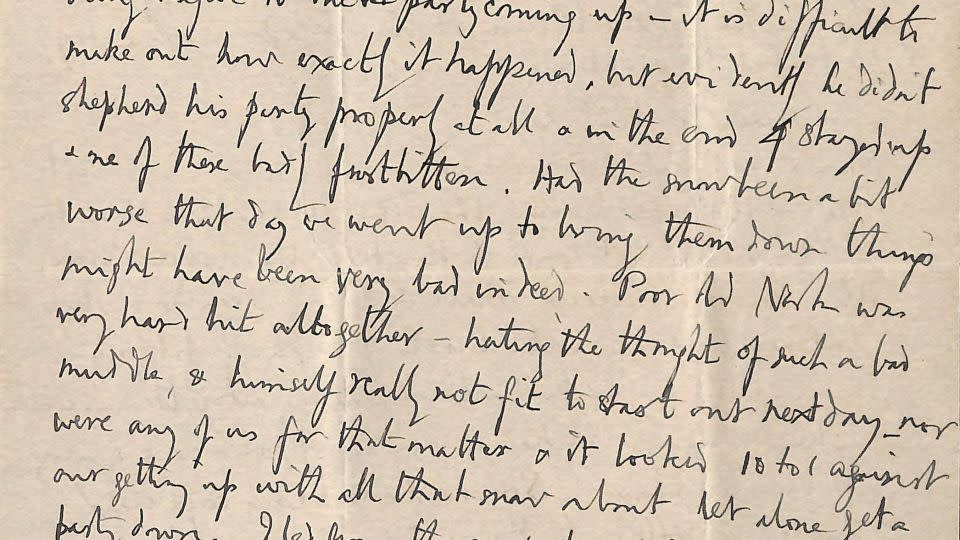

Mount Everest, the highest peak in the Himalayan mountain range, is also the highest mountain in the world, rising 29,035 feet (8,850 meters) above sea level on the border between the Nepal and Tibet, an autonomous region of China. Her Tibetan name is Chomolungma, meaning “Mother Goddess of the World,” and her Nepali name is Sagarmatha, meaning “Goddess of the Sky.”
However, these names were unknown to the 19th-century British surveyors who mapped the area, and in 1865 the Royal Geographical Society named the summit of Mount Everest after the British surveyor Sir George Everest, former Surveyor General of India.
Mallory took part in the first three British forays to the slopes of Everest: in 1921, 1922 and 1924. When he disappeared in 1924, he was less than two weeks shy of his 38th birthday.
Many wonder if Mallory and Irvine managed to reach the summit of Everest. The climbers were last seen in the early afternoon of June 8 by expedition member and geologist Noel Odell, who was following them and saw them from a distance. Odell later found some of their equipment at a campsite, but there was no trace of Mallory and Irvine.
“(Mallory) risked a lot despite having a family at home and three young children,” Hemmleb said. “We don’t know if it was really irresponsible to make this last attempt, because we don’t really know what happened. It could be that in the end, he was just unlucky.
So close and yet so far
Decades after Mallory’s death, Sherpa Tenzing Norgay and New Zealand mountaineer Sir Edmund Hillary became the first to reach the summit of Everest on May 29, 1953. In the years that followed, thousands of people have attempted to climb Everest, and almost 4,000 people have reached its summit. More than 330 climbers have died trying since modern records were kept, according to the Himalayan database, which compiles records of all Himalayan expeditions; Some of these bodies remain on the mountain, frozen where they fell and visible to climbers who pass them.
“If you’re in that environment, you make peace with your own mortality and the mortality of others,” Anker said. “You’re above 8,000 meters, and when there are weather changes or your own systems stop working due to lack of oxygen, things get serious very quickly.”
When climbers get closer to the summit of a mountain, they sometimes even advance in dangerous conditions due to so-called summit fever, a compulsion to reach the summit even at the expense of their own safety. It is not known whether Mallory was in the grip of summit fever when he died, but he might have believed that his reputation depended on climbing peaks.
“It was going to be the defining moment of his life,” Anker said.
In comparison, Edward Norton, a member of Mallory’s team, had attempted to reach the summit four days earlier, but turned back at roughly the same altitude where Mallory and Irvine were last seen .
“I had a conversation with one of Edward Norton’s sons a few years ago,” Hemmleb said. “When I asked him, do you think it was just luck that your father survived and Mallory died?” He replied: “No, I think there was a difference: my father, Edward Norton, didn’t do it. need the mountain.'”
As a climber himself, Hemmleb took this message to heart.
“That’s something I personally learned from Mallory,” he said. “You have to be very careful not to make yourself dependent on the success of this summit. »
A century has passed since Mallory’s death, but digitizing these letters ensures her story will continue to be told, Hemmleb said.
“This will continue beyond my lifetime, I’m sure,” he added. “In a sense, it’s an expedition that never ends.”
Mindy Weisberger is a science writer and media producer whose work has appeared in Live Science, Scientific American, and How It Works magazines.
For more CNN news and newsletters, create an account at CNN.com
yahoo


